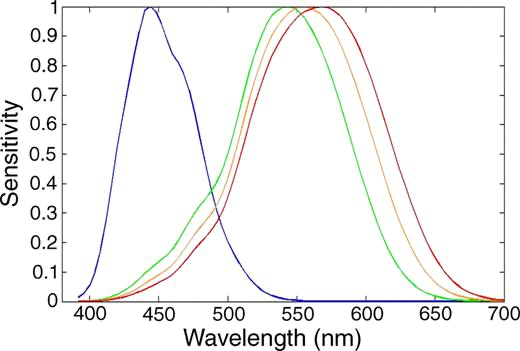
Stick with me here, there is a surprising twist coming up a the end.
In your eye you have rods and cones. These are terms used to describe specialised light-sensitive cells. Rods are sensitive to low light and so they will help you to see in very dim conditions. It is the cones that enable you to see different colors. What these cells do is to convert light into electrical signals that your brain will then interpret.
Now here is an interesting question – if I hold up a green leaf and show it to you, is your experience of green the same as mine or are you experiencing something completely different and you label that as green?

This feels like one of those student philosophy questions that can be chewed on over a few beers, and so you might be tempted to consider the thought that we might never really know because it is so very subjective. However, a rather interesting little study has been published that attempts to objectively address this.
The Study
Titled, “Is my “red” your “red”?: Evaluating structural correspondences between color similarity judgments using unsupervised alignment” and published within Cell Symosia on March 21, 2025 it takes what is termed a “structural approach” to compare different individual experiences of color perception.
This study by researchers from Tokyo University and also Monash University in Australia does not fully answer the question, but it is a rather interesting step on the road to an answer.
We might indeed as individuals compare notes and agree that a leaf is green, but is my green actually your red, and your red is my green, has your brain flipped the subjective interpretation around?
So how can they every begin to tackle this?
Associate Professor Masafumi Oizumi from Tokyo explains like this …
“To begin to unpick this, we need to separate the experience of colors that people have from their labels, the color terms like ‘red’ and ‘green,’ that people use when they refer to them, Although it is notoriously difficult to explain our internal experience of ‘red’ by referring only to ‘red’ itself, we can relatively easily describe the relations between our experiences. For example, the experience of red is closer to pink than to green. Our strategy is to accumulate as many such relations between our experiences, or qualia, as possible.”
Huh?
We rather obviously can’t directly compare the subjective experiences of individuals, but we can however create indirect characterisations and then compare those.
To tackle this they have created a means to ask people “What is it like?“
Literally.
They did an on-line survey that involved 426 people with normal color vision and also 257 people who had some variation of color blindness.
Without giving a color a name (such as red), they asked “Which other colors is this closest to”, and so they built up an association map for each participant’s experience of colors. As a control they also had people who were colorblind.
If indeed our subjective experience of color is universally the same, then we should in theory expect those with no color blindness to build the same network of color associations, and those with color blindness to build a different network of color associations.
For example if presented with lavender then most of you (and I) would consider it to be closer to purple than green.
The results?
A similar network of associations is indeed what they found …
“Using massive online experimental data from both color-neurotypical and colorblind participants, we empirically found that color similarity judgment data derived from color-neurotypical participants can be correctly aligned at the group level, such that red correctly mapped to the same red or similar reddish colors.
In contrast, those of colorblind participants could not be aligned with those of color-neurotypical participants, implying that color-neurotypical red is relationally equivalent to other color-neurotypical’s red, but not to colorblind people’s red.”
This is not a surprise.
We all have the same cones and rods and the same brain architecture. Because of that we have no reason to think that anyone’s subjective experience of something as fundamental as just color would be fundamentally different than anyone else’s … except where there is a natural variation of perception due to color blindness.
The result, while not ironclad, does indeed point to the subjective experience of color being consistent – My Green really is most probably the same as your green.
Interesting – but does it really matter?
Beyond the immediate question of “Is my red and green the same as your red and green?“, the approach itself presents us with a fascinating new tool that can be used to explore other subjective experiences in an empirical manner.
Right now we don’t truly understand consciousness, and so having a tool that enables us to explore subjective experiences like this will allow us to expand the boundary of what we know a little bit further.
An Interesting Twist – Tetrachromacy
OK, I promised a surprising twist, so here you go.
The vast majority of people have three types of cone cells, hence the human experience of vision is a common to most of us …

However, there are others species who, along with some humans, have four cone cells and not three – Tetrachromacy …

Why?
Having four cone cells is common in some species of birds, fish, reptiles, and also some humans. This is because the common ancestor of all vertebrates had four cone cells. We ended up with just three because the common ancestor of mammals lost two and then primates (including us) evolved a third. However a very small percentage of humans have four.
It is distinctly possible that there are people out there who really do see differently than most of us do.
Initially the thinking was perhaps not.
What is known is that the mothers and daughters of colour-blind men have three normal cones and one mutant cone. That makes it a tad easier to find women who have four cones. However, when tested back in the late 1940s, it was found that their colour vision was not enhanced in any way, so clearly the fourth cone cell was not functioning.
More recently Gabriele Jordan from Newcastle University, decided to research this and try something different. She tested 25 women who had this extra cone cell with a special test in which she flashed three coloured circles of light in their eyes. Those of us with three functioning cone cells would not see any difference, but somebody with four cone cells should be able to tell them apart. One of those she tested was able to do just that, she really could see differences each and every time.
So one case has been confirmed …
- You can find her 2010 paper on the discovery here: The dimensionality of color vision in carriers of anomalous trichromacy

Does anybody have any thoughts on what she might be seeing that we don’t see?
Further Reading
- The study in Cell Symosia: Is my “red” your “red”?: Evaluating structural correspondences between color similarity judgments using unsupervised alignment
- Wikipedia – Tetrachromacy
- Journal of Vision 2010 Paper: The dimensionality of color vision in carriers of anomalous trichromacy